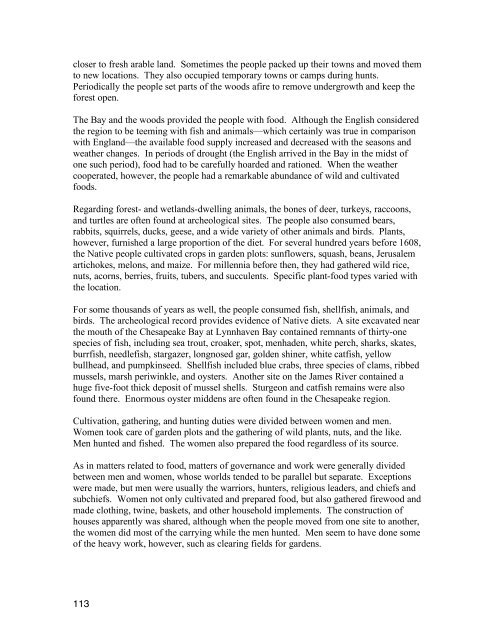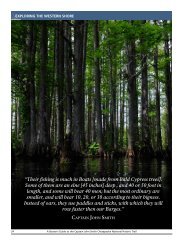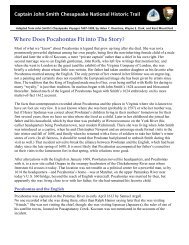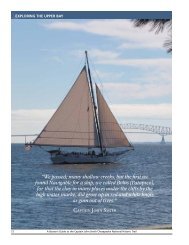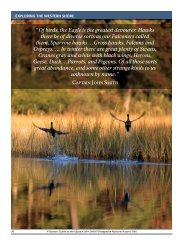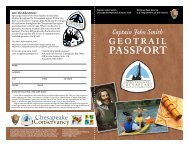Draft Interpretive Plan Join the adventure! - Captain John Smith ...
Draft Interpretive Plan Join the adventure! - Captain John Smith ...
Draft Interpretive Plan Join the adventure! - Captain John Smith ...
You also want an ePaper? Increase the reach of your titles
YUMPU automatically turns print PDFs into web optimized ePapers that Google loves.
closer to fresh arable land. Sometimes <strong>the</strong> people packed up <strong>the</strong>ir towns and moved <strong>the</strong>m<br />
to new locations. They also occupied temporary towns or camps during hunts.<br />
Periodically <strong>the</strong> people set parts of <strong>the</strong> woods afire to remove undergrowth and keep <strong>the</strong><br />
forest open.<br />
The Bay and <strong>the</strong> woods provided <strong>the</strong> people with food. Although <strong>the</strong> English considered<br />
<strong>the</strong> region to be teeming with fish and animals—which certainly was true in comparison<br />
with England—<strong>the</strong> available food supply increased and decreased with <strong>the</strong> seasons and<br />
wea<strong>the</strong>r changes. In periods of drought (<strong>the</strong> English arrived in <strong>the</strong> Bay in <strong>the</strong> midst of<br />
one such period), food had to be carefully hoarded and rationed. When <strong>the</strong> wea<strong>the</strong>r<br />
cooperated, however, <strong>the</strong> people had a remarkable abundance of wild and cultivated<br />
foods.<br />
Regarding forest- and wetlands-dwelling animals, <strong>the</strong> bones of deer, turkeys, raccoons,<br />
and turtles are often found at archeological sites. The people also consumed bears,<br />
rabbits, squirrels, ducks, geese, and a wide variety of o<strong>the</strong>r animals and birds. <strong>Plan</strong>ts,<br />
however, furnished a large proportion of <strong>the</strong> diet. For several hundred years before 1608,<br />
<strong>the</strong> Native people cultivated crops in garden plots: sunflowers, squash, beans, Jerusalem<br />
artichokes, melons, and maize. For millennia before <strong>the</strong>n, <strong>the</strong>y had ga<strong>the</strong>red wild rice,<br />
nuts, acorns, berries, fruits, tubers, and succulents. Specific plant-food types varied with<br />
<strong>the</strong> location.<br />
For some thousands of years as well, <strong>the</strong> people consumed fish, shellfish, animals, and<br />
birds. The archeological record provides evidence of Native diets. A site excavated near<br />
<strong>the</strong> mouth of <strong>the</strong> Chesapeake Bay at Lynnhaven Bay contained remnants of thirty-one<br />
species of fish, including sea trout, croaker, spot, menhaden, white perch, sharks, skates,<br />
burrfish, needlefish, stargazer, longnosed gar, golden shiner, white catfish, yellow<br />
bullhead, and pumpkinseed. Shellfish included blue crabs, three species of clams, ribbed<br />
mussels, marsh periwinkle, and oysters. Ano<strong>the</strong>r site on <strong>the</strong> James River contained a<br />
huge five-foot thick deposit of mussel shells. Sturgeon and catfish remains were also<br />
found <strong>the</strong>re. Enormous oyster middens are often found in <strong>the</strong> Chesapeake region.<br />
Cultivation, ga<strong>the</strong>ring, and hunting duties were divided between women and men.<br />
Women took care of garden plots and <strong>the</strong> ga<strong>the</strong>ring of wild plants, nuts, and <strong>the</strong> like.<br />
Men hunted and fished. The women also prepared <strong>the</strong> food regardless of its source.<br />
As in matters related to food, matters of governance and work were generally divided<br />
between men and women, whose worlds tended to be parallel but separate. Exceptions<br />
were made, but men were usually <strong>the</strong> warriors, hunters, religious leaders, and chiefs and<br />
subchiefs. Women not only cultivated and prepared food, but also ga<strong>the</strong>red firewood and<br />
made clothing, twine, baskets, and o<strong>the</strong>r household implements. The construction of<br />
houses apparently was shared, although when <strong>the</strong> people moved from one site to ano<strong>the</strong>r,<br />
<strong>the</strong> women did most of <strong>the</strong> carrying while <strong>the</strong> men hunted. Men seem to have done some<br />
of <strong>the</strong> heavy work, however, such as clearing fields for gardens.<br />
113


